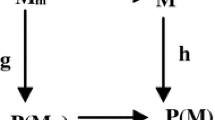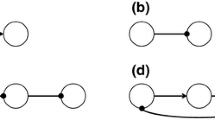Summary
In the literature the term “natural balance” occurs frequently and is used for highly divergent collections of facts and for results arrived at by different methods. In this paper it is attempted (1) to give a review of the many possible meanings of “balance in nature”, and (2) to evaluate the application of the term in the scientific literature.
To achieve this twofold objective it seemed useful to start by giving as objective as possible a description of the “balance situation” in natural communities, in analogy with the original physical concept and according to strict scientific criteria. On the basis of this working standard, part of the ecological literature is discussed with respect to statements and presumptions concerning “balance”. The extensive literature is classified according to several groups, on the one hand on the basis of the nature of the views (e.g. mathematical, deterministic, stochastic,etc.), on the other hand according to the importance that certain authors attach to the theory of a given author. For each of these groups, an evaluation of the content of the term “balance” is given. It was found that the reasoning is not always sound and that the nature of the data on which the concept is based varies widely, which also holds for the method of reasoning applied in the conclusions drawn. In none of the publications arguments were found supporting the existence of a natural “balance situation” as formulated in the standard description. Consequently, it seemed justified to conclude that it is not correct to apply a concept “natural balance”, defined purely scientifically, to natural situations, either because “balance” in the indicated sense is simply not present or because the situation under consideration is not a natural one (experimental communities). The concept “natural balance” has had only heuristic value for scientific research. In other contexts it has a different value, because there criteria other than scientific or methodological ones hold for the content of a concept. It is therefore not objectionable to use the term “natural balance” in common parlance, especially since this usage makes it possible to convey to the layman a great deal in few words.
Similar content being viewed by others
Bibliography
Allee, W. C., Emerson, A. E., Park, O., Park, T. &Schmidt, K. P. (1949). Principles of animal ecology.-Philadelphia, London, W. B. Saunders Company, 838 p.
Andrewartha, H. G. (1957). The use of conceptual models in population ecology.- Cold Spring Harbour Symposia on quantitative Biology,22, p. 219–236.
— (1961). Introduction to the study of animal populations.-London, Methuen, xvii + 281 p.
— &Birch, L. C. (1954). The distribution and abundance of animals. - Chicago, Univ. of Chicago Press, 782 p.
Barker, K. (1964). Backgrounds of controversies about population theories and their terminologies.- Z. angew. Ent.,55, p. 187–208.
Beckner, M. (1968). The biological way of thought.-Berkeley, Los Angeles, Univ. Press of California, viii + 200 p.
Bertalanffy, L.von (1949). Das biologische Weltbild. Bd. I: Die Stellung des Lebens in Natur und Wissenschaft.-Bern, A. Francke, 202 p.
Boer, P. J. den (1968). Spreading of risk and stabilisation of animal numbers.- Acta Biotheoretica,18, p. 165–194.
Bodenheimer, F. S. (1938). Problems of animal ecology.-London, Oxford, Univ. Press.
- (1958). Animal ecology to-day.-Den Haag, 276 p.
Bunge, M. (1962). Intuition and science.-Englewood Cliffs, N.J., Prentice Hall, x + 412 p.
Chapman, R. N. (1931). Animal ecology with special reference to insects.-New York, London, Mc Graw Hill Book Company Inc., 464 p.
Clements, F. E. (1949). Dynamics of vegetation.-New York, Wilson, xxiii + 296 p.
— &Shelford, V. E. (1939). Bio-ecology. - London, Chapman & Hall, 425 p.
Dotterweich, H. (1940). Das biologische Gleichgewicht und seine Bedeutung für die Hauptprobleme der Biologie.-Jena, Fischer, vii + 236 p.
Dunbar, M. J. (1959). The evolution of stability: natural selection at the level of the ecosystem.-In:T. W. M. Cameron, Ed., Evolution: its science and doctrine. Toronto, Univ. of Toronto Press, p. 98–109.
Elsasser, W. M. (1961). Quanta and the concept of organismic law.-J. Theor. Biol.,I, p. 27–58.
Elton, C. S. (1930). Animal ecology and evolution.-Oxford, Oxford Univ. Press, 96 p.
— (1947). Animal Ecology.-London, Sedgwick & Jackson, xx + 209 p.
— (1958). The ecology of invasions by animals and plants.-London, Methuen & Co, 181 p.
Frolow, I. T. (1963). Kausalität und Zweckmäßigkeit in der lebenden Natur.- Berlin, VEB. Deutscher Verlag der Wissenschaften, 180 p.
Howard, L. O. &Fiske, W. F. (1911). The importation into the United States of the parasites of the gipsy moth and the brown-tail moth.-Bull, of U.S. Department of Agriculture; bureau of Entomology,91. Washington, Gov. Printing Office, 344 p.
Jeuken, M. (1951). The concept “individual” in biology.-Acta Biotheoretica,10, p. 57–86.
— (1968). A note on models and explanation in biology.-Acta Biotheoretica,18, p. 284–290.
Klaauw, C. J. van der (1959). Teleologie in de moderne biologie.-Alg. Ned. Tijdschr. Wijsbeg. Psychol.,52, p. 68–79.
Klomp, H. (1966). The dynamics of a field population of the pine looper,Bupalus piniarius L. (Lep., Geom.).-In:Cragg, J. B., Advances in ecological research, Vol. 3, p. 207–305.-London, New York, Acad. Press.
Kusnezov, N. (1958). Gesetze der organischen Evolution.-Acta Biotheoretica,3, p. 47–86.
Lack, D. (1954). The natural regulation of animal numbers.-Oxford, Clarendon Press, viii + 343 p.
Mayr, E. (1940). Animal species and evolution.-Cambridge, Mass., The Belknap Press of Harvard Univ. Press, xiv + 797 p.
-(1965). Cause and effect in biology.-In:Lerner, D., ed., Cause and effect.- New York, p. 33–50.
Meltzer, J. &Westhoff, V. (1942). Inleiding tot de plantensociologie.-s'-Gravenland, G. W. Breughel, 326 p.
Milne, A. (1957). Theories of natural control of insect populations.-In: Cold Spring Harbour Symposia on Quant. Biol.,22, p. 253–271.
— (1962). On a theory of natural control of insect populations.-J. Theor. Biol.,3, P- 19–50.
Nicholson, A. J. (1933). The balance of animal populations.-J. Anim. Ecol.,2, p. 131–178.
— (1954)- An outline of the dynamics of animal populations.-Austr. J. Zool.,2, p. 9–65.
— (1957). The self-adjustment of populations to change.-In: C.S.H. Symposia on Quant. Biol.,22, p. 153–174.
— &Bailey, V. A. (1935). The balance of animal populations.-Proc. Zool. Soc. London,3, p. 551–598.
Orians, G. H. (1962). Natural selection and ecological theory.-Am. Nat.,96, p. 257–263.
Reddingius, J. (1968). Gambling for existence.-Groningen, Univ. Press, ix + 172 p.
Rensch, B. (1959). Evolution above the species level.-London, Methuen, xvii + 419 p.
Richards, O.W. (1961). The theoretical and practical study of natural insect populations.-Am. Rev. Ent.,6, p. 147–162.
Schaefer, H. (1956). Die Stellung der Regelungstheorie im System der Wissenschaft.-In:Mittelstaedt, H., Regelungsvorgänge in der Biologie.-München, R. Oldenburg, p. 26–47.
Slobodkin, L. B. (1962). Growth and regulation of animal populations.-New York, Holt, Rinehart & Winston, viii + 184 p.
Smith, H. S. (1935). The role of biotic factors in determining population densities.- J. Econ. Ent.,28, p. 873–898.
Smuts, J. C. (1927). Holism and evolution.-London, Macmillan, p. xiii + 358 p.
Solomon, M. E. (1949). The natural control of animal populations.-J. Anim. Ecol.,18, p. 1–35.
Spencer, H. (1894). The principles of biology, Vol. 1.-London, Edinburgh, Williams & Norgate, xiii + 432 p.
Thompson, W. R. (1929). On natural control.-Parasitology,21, p. 269–281.
— (1939). Biological control and the theories of interactions of populations.- Parasitology,31, p. 299–388.
— (1956). The fundamental theory of natural and biological control.-Ann. Rev. Ent.,1, p. 379–402.
Varley, C. G. (1947). Natural control of populations balance in the knapweed gallfly.- J. Anim. Ecol.,16, p. 139–187.
Veen, R. van der (1961). Het biologisch evenwicht.-Utrecht, Univ. Press, 16 p.
Voûte, A. D. (1968). Ecology as a teleological science.-Acta Biotheoretica,18, p. 143–164.
Watt, K. E. F. (1968). Ecology and resource management.-New York, Mc Graw Hill Book Comp., xii + 450 p.
Welten, W. P. van (1961). Causaliteit in de quantummechanica.-Groningen, Noordhoff, 323 p.
Woodger, J. H. (1960). Biology and physics.-Brit. J. Phil. Sa,11, p. 89–100.
— (1968). Biological principles.-London, Routledge & Kegan Paul, xix + 496 p.
Author information
Authors and Affiliations
Rights and permissions
About this article
Cite this article
Jansen, A.J. An analysis of “balance in nature” as an ecological concept. Acta Biotheor 21, 86–114 (1972). https://doi.org/10.1007/BF01556339
Received:
Issue Date:
DOI: https://doi.org/10.1007/BF01556339




